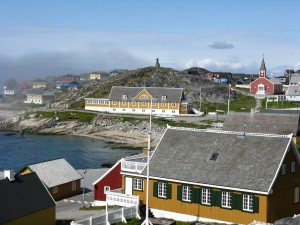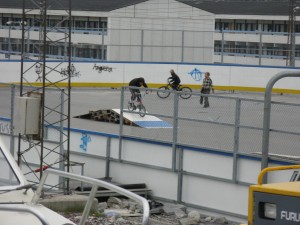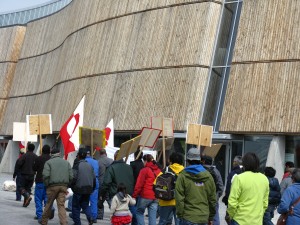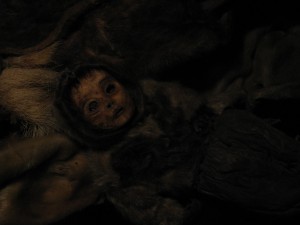
Nuuk's historic old town
I began my journey in Nuuk, Greenland’s capital and––with 17,000 residents––by far its biggest city. My first impression was that it was warm––warmer, anyway, than I had feared––and after locating my bag (there were only about twenty of us on the twin-propeller plane from Reykjavik) I hiked down the hill from the airport to a rocky patch of grass along the Labrador Sea, where wild camping seemed possible. With a traditional turf hut built into the hillside on one side of my tent and a view of the craggy Sermitisiaq mountain across the water on the other, it all seemed pretty idyllic. But I learned the hard way that weather changes quickly in Greenland––so much so that long underwear, fleece, a wool hat and gloves aren’t always going to cut it inside a sleeping bag. The next morning I packed up quickly and found a warm bed inside the Godthåbshallen––a cavernous youth sports complex overlooking a graffiti-covered skate park. The “hostel” is really a bunk room that accommodates visiting sports teams. Thankfully, no matches were scheduled during my visit.

View from the Godthåbshallen
Nuuk was founded in 1728 by a Danish missionary whose effigy looms large over the picturesque old quarter of the town. It only really boomed in the 1950s, when Denmark made an effort to modernize the country by erecting enormous concrete housing blocks, which are now in a pretty sorry state. The contrast between the quaint historical center––where it’s still possible to see families walking on Sunday in traditional embroidered sweaters, white kamik boots, and sealskin pants––and the looming, paint-peeled housing projects is pretty stark. It’s a tension that’s apparent all over town, from the austere cemetery with naked white crosses that sits next to a fast food restaurant, to the apartment buildings where reindeer antlers hang beside TV antennas.

Old and new in Nuuk
For me, the twin highlights of Nuuk were the Katuaq Cultural Center and the National Museum. The former––a sleek, modern building that curves along the street like a wood and glass wave––accessibly blends modern Danish design with a more traditional Greenlandic aesthetic. The successful commingling transcends the architecture, too––the coffeeshop is a warm and welcoming place to read Politiken or gather large families for lunch. In a town where national/colonial tensions are sometimes palpable, Katuaq felt–to an outsider, anyway––like a space that defused some of that.

Protest outside Katuaq Cultural Center
The other real highlight is the small but bountiful National Museum, which was full of artifacts and displays that are going to be useful for my project (I lingered for hours taking notes). The highlight, featured some time ago on a National Geographic cover, are the Qilakitsoq mummies, a group of eerily well preserved 15th-century Inuit, wrapped in furs. But there are many other fascinating relics, covering everything from Pre-Dorset cultures to 18th-century whaling to the post-1950s period of modernization.

One of the Qllakitsoq mummies
Rumors of a strike down by the docks left me uncertain just where my ferry would leave from, and I spent my last morning racing between harbors. I successfully found the tiny boat, though, and headed north to Maniitsoq.
